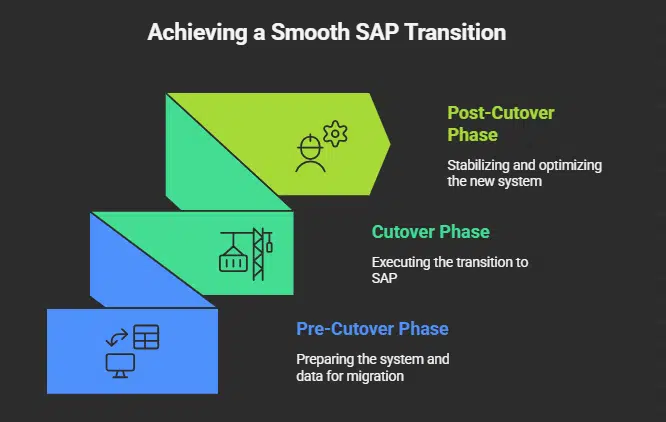Strategic Planning and Execution. When converting to SAP, cutover plans are crucial to ensure a smooth transition. The use of a phased go-live strategy reduces risks significantly and improves the overall effectiveness of the implementation. In this article, we’ll look at the intricacies of the SAP cutting plan’s 3 phases – the pre-cutover stage, the cutover phase, and the post-cutover phase – with potential solutions.
Table of Contents
Understanding the Phased SAP Cutover Plan
Phased cutover plans require performing the transition step-by-step rather than all at one time. This technique allows for thorough tests and validation before moving forward, which reduces disruptions and makes for a smoother launch process. The key phases of these cutover plans can include:

Pre-Cutover Phase
The initial stage usually occurs approximately two weeks before the core launch date and is used to complete technical and business preparations. Here’s a breakdown of the tasks required.
- The Legacy System Freeze/Cutoff: The freezing of the legacy transactional systems is vital to ensure that data is consistent throughout the migration.
- Master Data Load: Completion of the master information loading in SAP, for example, open inventory, receipts, orders and vendor/customer information. Validate System Configuration Validation: Check configurations on the system to ensure they meet the requirements of the business.
- Test reconciliations for the integrity of the data. Interface and Integral testing should be done in this phase to ensure that data flows are smooth across modules (e.g. MM-SD-FI flows).
- Conduct security and performance audits: Conduct extensive reviews of the system’s performance and security in order to find any vulnerabilities, including training for end users and change management tasks to facilitate an easy transition.
- Mock cutovers as well as formal readiness reviews: To model the go-live process and identify any issues that might arise. Conduct at least one or two mock cutovers or formal readiness reviews prior to the date of the date for launch.
- Go/NoGo Review: Prior to the launch, conduct a formal Go/No-Go Review with your Steering Committee and reviewers (usually two weeks before) to ensure that the tasks have been completed and that risks have been appropriately reduced.
Cutover Phase
The cutover phase is officially the transition process to SAP. A proper execution and coordination at this phase is crucial for ensuring a seamless transition. Key tasks could include:
- Final Data Migration Make sure that all the necessary information from the old systems to SAP is accurately transferred.
- System activation and testing Start the SAP system and test its capabilities.
- Post-migration validation: After it has been a while since the migration, perform post-migration validation tests to ensure accuracy of the data and the system’s performance. Resolution of issues: Address any issues during cutting over when they occur to ensure smooth operation.
Post-Cutover Phase
Post-cutover work is focused on stabilisation and optimisation to make sure that SAP systems run smoothly. SAP systems. They have responsibilities comprising:
- Monitoring: Continuously monitor and maintain the SAP system to identify and fix any issues or mistakes that may arise.
- The performance tuning process helps fine-tune your system’s performance to meet the needs of business. Support for End-Users: Provide continuous support for users’ questions or concerns.
- Conduct post-go-live reviews: Begin post-go-live reviews that evaluate the effectiveness of the changeover and identify areas that require further improvement.
Conclusion
A SAP cutover strategy is vital to ensure a smooth transition from older software to SAP. Through careful planning and execution of every step, companies are able to lower risks, increase efficiency and guarantee a soft launch. By performing rigorous tests and validations and also undergoing instruction prior to moving to SAP they can confidently embrace SAP’s powerful capabilities to accelerate growth and development of the company.
Whatever the case, whether it’s your first SAP implementation or simply trying to improve your existing processes knowing a phased cutover method increases the chances of success. This strategy not only helps ensure that there are no interruptions, but it is also ensures that the new system is in sync with the needs of your business, making for an exciting and thrilling journey to come.!
You might also find the following articles interesting.
- fiori configuration guide
- SAP ecc to s4hana data migration
- earn sap btp
- Retail insights with sap car
- leanix an introductory guide
- building side by side extensions on sap btp
- sap ecc vs s4 hana key changes and benefits
- sap ides
- Understanding rfno in sap s4hana
- SAP Clean Core
- SAP ABAP begnner’s journey
- Grow with sap vs rise with sap comparison
- Rise with sap
- Year-end activities in sap
- SAP TM Transaction codes
- ethical ai development
- sap migration data configuration tools
- simplifying sap s4hana custom code migration
- sap ewm integration
- sap project intelligence network
- advanced production integration with sap ewm
- Credit management comparison of sap fscm
- SAP EWM
- sap s4hana migration
- GST E invoice
- understanding abap objects
- SAP interfaces
- Joule ai copilot
- Mastering sap background job processing
- SAP Ewm tcodes a handy guide
- Object-oriented programming in sap abap
- understanding sap license costs
- SAP Datasphere
- industry4.0 with sap
- Condition contract management in sap s4 hana
- Comprehensive guide to go live
- SAP EHS Module
- Power of generative ai in sap
- SAP Joule Comprehensive Guide
- Mastering the dunning process sap
- Creation of chart of accounts in sap fico
- Different roles of an sap consultant
- understanding sap system landscape
- Product costing in sap
- Copa in sap
- subcontracting process in sap mm
- SAP S4hana cloud
- Disaster Recovery in SAP HANA Cloud